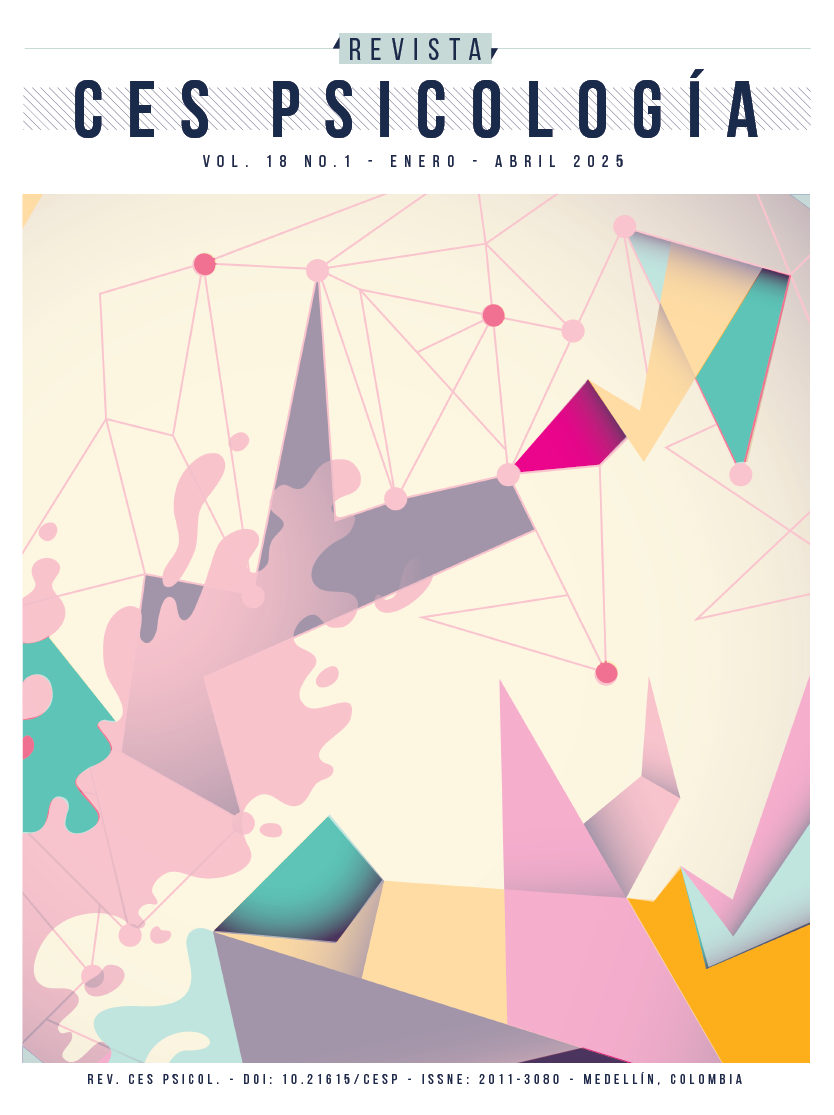Relationship between dark triad traits and parental communication in a sample of parents with school-aged children
DOI:
https://doi.org/10.21615/cesp.7285Keywords:
Dark Triad, parental communication, family functioning, family implicationsAbstract
Family communication is fundamental in the healthy development of children and adolescents. However, there are factors that impair family communication, like parental psychopathology. Given the scarcity of literature regarding this type of relationship, the present investigation has as main objectives: explore the association between the personality traits that constitute the Dark Triad and the different types of parental communication, verify if there are differences in personality traits that comprise the Dark Triad according to gender and analyze the predictor role of the Dark Triad in parental communication. The sample was constituted of 290 children/teenagers’ parents in school age between 7 and 16 years, 231 participants were female and 59 males, with ages between 28 and 66 years. The measures used were Dark Triad Dirty Dozen Scale (TN-12), the Perception Scale of Parenting Communication – parents version (COMPA-P) and a social demographic questionnaire. The results suggest that narcissism is negatively associated with all dimensions of parental communication, while Machiavellianism is not associated with any dimension, psychopathy is negatively associated with the expression of affection and emotional support, and psychopathy predicts some dimensions of parental communication. In conclusion, the results become relevant for the development of programs/formations to the health care workers, to sensitize them about the magnitude of this problem, and its consequences and provide tools to assess and intervene.
Downloads
References
Barber, N. (1994). Machiavellianism and altruism: Effect of relatedness of target person on machiavellian and helping attitudes. Psychological Reports, 75(1), 403-422. https://doi.org/10.2466/pr0.1994.75.1.403
Barker, L. L. (1987). Communication (4th ed.). Prentice-Hall.
Brothers, D. (2009). Trauma‐centered psychoanalysis: Transforming experiences of unbearable uncertainty. Annals of the New York Academy of Sciences, 1159(1), 51-62. https://doi.org/10.1111/j.1749-6632.2009.04350.x
Cairncross, M., Veselka, L., Schermer, J. A., & Vernon, P. A. (2013). A behavioral genetic analysis of alexithymia and the dark triad traits of personality. Twin Research and Human Genetics, 16(3), 690-697. https://doi.org/10.1017/thg.2013.19
Carr, A. (2006). Family therapy: Concepts, process and practice (2nd ed.). John Wiley & Sons.
Carter, G. L., Campbell, A. C., Muncer, S., & Carter, K. A. (2015). A Mokken analysis of the Dark Triad ‘Dirty Dozen’: Sex and age differences in scale structures, and issues with individual items. Personality and Individual Differences, 83, 185-191. https://doi.org/10.1016/j.paid.2015.04.012
Cassidy, B., Zoccolillo, M., & Hughes, S. (1996). Psychopathology in adolescent mothers and its effects on mother-infant interactions: A pilot study. The Canadian Journal of Psychiatry, 41(6), 379-384. https://doi.org/10.1177/070674379604100609
Christie, R. (1970). Why Machiavelli? In R. Christie & M. Geis (Eds.), Studies in machiavellianism (1st ed., pp. 1–9). Elsevier.
Cohen, J. (1988). Set correlation and contingency tables. Applied Psychological
Measurement, 12(4), 425-434. https://doi.org/10.1177/014662168801200410
Ehrensaft, M. K., Wasserman, G. A., Verdelli, L., Greenwald, S., Miller, L. S., & Davies, M. (2003). Maternal antisocial behavior, parenting practices, and behavior problems in boys at risk for antisocial behavior. Journal of Child and Family Studies, 12(1), 27-40. https://doi.org/10.1023/A:1021302024583
Fanti, K. A., & Lordos, A. (2022). Parental antisocial and psychopathic traits influence adolescent psychopathology. International Journal of Offender Therapy and Comparative Criminology, 66(15), 1550-1574. https://doi.org/10.1177/0306624x211013517
Fanti, K. A. (2018). Understanding heterogeneity in conduct disorder: A review of psychophysiological studies. Neuroscience & Biobehavioral Reviews, 91, 4–20. https://doi.org/10.1016/j.neubiorev.2016.09.022
Fanti, K. A., Kyranides M. N., Georgiou, G., Petridou, M., Colins, O. F., Tuvblad, C., & Andershed, H. (2017). Callous-unemotional, impulsive-irresponsible, and grandiose-manipulative traits: Distinct associations with heart rate, skin conductance, and startle responses to violent and erotic scenes. Psychophysiology, 54(5), 663–672. https://doi.org/10.1111/psyp.12837
Fiske, J. (2005). Introdução ao estudo da comunicação (9a ed.). ASA Editores.
Furnham, A., Richards, S. C., & Paulhus, D. L. (2013). The dark triad of personality: A 10 year review. Social and Personality Psychology Compass, 7(3), 199-216. https://doi.org/10.1111/spc3.12018
Hare, R. D. (1996). Psychopathy and antisocial personality disorder: A case of diagnostic confusion. Psychiatric Times, 13(2), 39-40. https://www.psychiatrictimes.com/view/psychopathy-and-antisocial-personality-disorder-case-diagnostic-confusion
Horne, S. G. (1998). The role of parental narcissism and depression in predicting adolescent empathy, narcissism, self-esteem, pleasing others, and peer conflict. Unpublished master´s thesis. University of Georgia.
Johnson, J. G., Cohen, P., Kasen, S., & Brook, J. S. (2008). Psychiatric disorders in adolescence and early adulthood and risk for child-rearing difficulties during middle adulthood. Journal of Family Issues, 29(2), 210-233. https://doi.org/10.1177/0192513X07305349
Johnson, J. G., Cohen, P., Kasen, S., Ehrensaft, M. K., & Crawford, T. N. (2006). Associations of parental personality disorders and axis I disorders with childrearing behavior. Psychiatry, 69(4), 336-350. https://doi.org/10.1521/psyc.2006.69.4.336
Johnson, J. G., Cohen, P., Kasen, S., Smailes, E., & Brook, J. S. (2001). Association of maladaptive parental behavior with psychiatric disorder among parents and their offspring. Archives of General Psychiatry, 58(5), 453-460. https://doi.org/10.1001/archpsyc.58.5.453
Jonason, P. K., & Krause, L. (2013). The emotional deficits associated with the dark triad traits: Cognitive empathy, affective empathy, and alexithymia. Personality and Individual Differences, 55(5), 532-537. https://doi.org/10.1016/j.paid.2013.04.027
Jonason, P. K., & Webster, G. D. (2010). The dirty dozen: A concise measure of the dark triad. Psychological Assessment, 22(2), 420–432. https://doi.org/10.1037/a0019265
Kirkman, M., Rosenthal, D. A., & Shirley Feldman, S. (2005). Being open with your mouth shut: The meaning of ‘openness’ in family communication about sexuality. Sex Education, 5(1), 49-66. https://doi.org/10.1080/1468181042000301885
Kopp, L. M., & Beauchaine, T. P. (2007). Patterns of psychopathology in the families of children with conduct problems, depression, and both psychiatric conditions. Journal of Abnormal Child Psychology, 35(2), 301-312. https://doi.org/10.1007/s10802-006-9091-2
Kückelhaus, B., Kranefeld, I., & Blickle, G. (2022). Nonlinearity within dark triad constructs? The case for psychopathy and machiavellianism. Personality and Individual Differences, 190, 1-6. https://doi.org/10.1016/j.paid.2022.111521
Láng, A. (2018). Mama mach and papa mach: Parental machiavellianism in relation to dyadic coparenting and adolescents’ perception of parental behaviour. Europe’s Journal of Psychology, 14(1), 107-124. https://doi.org/10.23668/psycharchives.1288
Leedom, L. J., Bass, A., & Almas, L. H. (2013). The problem of parental psychopathy. Journal of Child Custody, 10(2), 154–184. https://doi.org/10.1080/15379418.2013.796268
Mahoney, D. M., Rickspoone, L., & Hull, J. C. (2016). Narcissism, parenting, complex trauma: The emotional consequences created for children by narcissistic parents. The Practitioner Scholar: Journal of Couseling & Professional Psychology, 5(1), 45-59.
Maneiro, L., Navas, M. P., Van Geel, M., Cutrín, O., & Vedder, P. (2020). Dark triad traits and risky behaviours: Identifying risk profiles from a person-centred approach. International Journal of Environmental Research and Public Health, 17(17), 1-14. https://doi.org/10.3390/ijerph17176194
Marôco, J. (2014). Análise das equações estruturais: Fundamentos teóricos, software & aplicações (1a ed.). ReportNumber.
Marôco, J. (2018). Análise estatística com o spss statistics (7a ed.). ReportNumber.
McIlwain, D. (2003). Bypassing empathy: A machiavellian theory of mind and sneaky power. In B. Repacholi & V. Slaughter (Eds.), Individual differences in theory of mind: Implications for typical and atypical development (1st ed., pp. 39–66). Psychology Press.
Muris, P., Merckelbach, H., Otgaar, H., & Meijer, E. (2017). The malevolent side of human nature: A meta-analysis and critical review of the literature on the dark triad (narcissism, machiavellianism, and psychopathy). Perspectives on Psychological Science, 12(2), 183-204. https://doi.org/10.1177/1745691616666070
Ojha, H. (2007). Parent-child interaction and machiavellian orientation. Journal of the Indian Academy of Applied Psychology, 33(2), 285–289.
Olson, D. H. (2000). Circumplex model of marital and family systems. Journal of Family Therapy, 22(2), 144-167. https://doi.org/10.1111/1467-6427.00144
Pallant, J. (2005). SPSS survival manual (2nd ed.). Allen & Unwin.
Paulhus, D., & Williams, K. (2002). The dark triad of personality: Narcissism, machiavellianism, and psychopathy. Journal of Research in Personality, 36(6), 556-563. https://doi.org/10.1016/S0092-6566(02)00505-6
Pechorro, P., Jonason, P. K., Raposo, V., & Maroco, J. (2021). Dirty dozen: A concise measure of dark triad traits among at-risk youths. Current Psychology, 40(7), 3522-3531. https://doi.org/10.1007/s12144-019-00288-9
Pilch, I. (2008). Machiavellianism, emotional intelligence and social competence: Are machiavellians interpersonally skilled? Polish Psychological Bulletin, 39(3), 158-164. https://www.researchgate.net/publication/236135631_Machiavellianism_emotional_intelligence_and_social_competence_Are_Machiavellians_interpersonally_skilled
Pineda, D., Sandín, B., & Muris, P. (2020). Psychometrics properties of the spanish version of two dark triad scales: The dirty dozen and the short dark triad. Current Psychology, 39(5), 1873-1881. https://doi.org/10.1007/s12144-018-9888-5
Portugal, A., & Alberto, I. (2013). A comunicação parento-filial: Estudo das dimensões comunicacionais realçadas por progenitores e por filhos. Psicologia: Reflexão e Crítica, 26(3), 319-326. https://doi.org/10.1590/S0102-79722013000300007
Portugal, A. P. M., & Alberto, I. M. M. (2014). Escala de Avaliação da Comunicação na Parentalidade (COMPA): Desenvolvimento e validação de uma medida da comunicação parento-filial. Avances en Psicologia Latinoamericana, 32(1), 85-103. https://doi.org/10.12804/apl32.1.2014.06
Portugal, A., & Alberto, S. (2014). Escala de avaliação da comunicação na parentalidade (COMPA). In A. Relvas & S. Major (Ed.), Avaliação familiar: Funcionamento e intervenção (1a ed., pp. 43–67). Imprensa da Universidade de Coimbra.
Ramos, V. (2020). Como Lidar com os Problemas de Comportamento das Crianças (1st ed.). Pactor.
Roberts, W., & Strayer, J. (1996). Empathy, emotional expressiveness, and prosocial behavior. Child Development, 67(2), 449-470. https://doi.org/10.1111/j.1467-8624.1996.tb01745.x
Ručević, S. (2022). Parental psychopathic traits and its interaction with children's psychopathy features as predictors of perceived parenting behavior five years later. Personality and Individual Differences, 189, 1-7. https://doi.org/10.1016/j.paid.2022.111512
Santos, M. C. (2021). Problemas de Saúde Mental em Crianças e Adolescentes: Identificar, avaliar e intervir (1st ed.). Edições Sílabo.
Segrin, C., & Flora, J. (2005). Family communication (1st ed.). Lawrence Erlbaum Associates.
Segrin, C. (2006). Invited article: Family interactions and well-being: Integrative perspectives. Journal of Family Communication, 6, 3-21. https://doi.org/10.1207/s15327698jfc0601_2
Shaw, D. (2010). Enter ghosts: The loss of intersubjectivity in clinical work with adult children of pathological narcissists. Psychoanalytic Dialogues, 20(1), 46-59. https://doi.org/10.1080/10481880903559120
Sillars, A., Koerner, A., & Fitzpatrick, M. A. (2006). Communication and understanding in parent–adolescent relationships. Human Communication Research, 31(1), 102-128. https://doi.org/10.1111/j.1468-2958.2005.tb00866.x
Thomaes, S., Bushman, B. J., De Castro, B. O., & Stegge, H. (2009). What makes narcissists bloom? A framework for research on the etiology and development of narcissism. Development and Psychopathology, 21(4), 1233-1247. https://doi.org/10.1017/S0954579409990137
Tomé, G., Gaspar de Matos, M., Camacho, I., Simões, C., & Diniz, J. A. (2012). Portuguese adolescents: The importance of parents and peer groups in positive health. Spanish Journal of Psychology, 15(3), 1315-1324. http://dx.doi.org/10.5209/rev_SJOP.2012.v15.n3.39417
Vangelisti, A. L. (2004). Handbook of Family Communication (1st ed.). Lawrence Erlbaum Associates, Publishers.
Wai, M., & Tiliopoulos, N. (2012). The affective and cognitive empathic nature of the dark triad of personality. Personality and Individual Differences, 52(7), 794-799. https://doi.org/10.1016/j.paid.2012.01.008
Watzlawick, P., Bavelas, J. B., & Jackson, D. (1967/1993). Pragmatics of human communication: A study of international patterns, pathologies, and paradoxes (1st ed.). W. W. Norton & Company.
Weinberg, M. K., & Tronick, E. Z. (1998). The impact of maternal psychiatric illness on infant development. Journal of Clinical Psychiatry, 59(2), 53-61. https://pubmed.ncbi.nlm.nih.gov/9559760/
Yendell, A., Clemens, V., Schuler, J., & Decker, O. (2022). What makes a violent mind? The interplay of parental rearing, dark triad personality traits and propensity for violence in a sample of German adolescents. PLoS One, 17(6), 1-12. https://doi.org/10.1371/journal.pone.0268992
Published
How to Cite
Issue
Section
License
Copyright (c) 2024 Mariagiulia Galluzzo, Margarida Simões, Inês Carvalho Relva

This work is licensed under a Creative Commons Attribution-NonCommercial-ShareAlike 4.0 International License.
Each manuscript is accompanied by a statement specifyingThat the materials are unpublished, that have not been previously published in printed formatElectronic and that they will not be presented to any other means before knowing the decision of the magazine. ThroughoutIn case, any previous publication, sea in printed or electronic form, must be made known to the editorial staffWriting The authors attach a signed statement stating that, and the manuscript is acceptedFor publication, the rights of reproduction are the exclusive property of the Journal CES Psychology.


